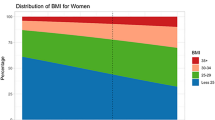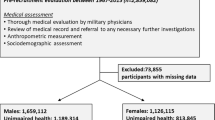Abstract
Objective:
To assess whether the composition of the obese category (body mass index (BMI)⩾30) has changed during the last one-third of a century in young adult men.
Design:
Retrospective study of 1 580 913 men (18.3±0.4 years) representing 82% of the Swedish male population at military conscription age between 1969 and 2005. Measured height and weight were used to define moderate and morbid obesity as BMI 30–34.9 and ⩾35, respectively. Data on socio-economic position (SEP), place of residence (urban, semi-urban and rural), age and test center were also collected.
Results:
From the period 1969–1974 to 2000–2005, the prevalence of moderate obesity almost quintupled (0.8–3.8%; P<0.0001), while morbid obesity increased 10-fold (0.1–1.3%; P<0.0001). The composition of the obese category changed from 12.9 to 25.1% morbidly obese during the same time, corresponding to an annual growth in the odds of 2.8% (CI95% 2.5–3.1%) per year within the obese category. Compared to 1969–1974, the odds ratios of obesity and morbid obesity, respectively, were 1.6 (1.6–1.7) and 1.9 (1.7–2.2) in 1980–1984, 2.8 (2.7–2.9) and 4.0 (3.5–4.5) in 1990–1994, and 6.0 (5.7–6.3) and 11.4 (10.1–12.9) in 2000–2005, after adjustment for SEP, urban/rural place of residence, age and test center. Extrapolation of the growth rate during the observation period resulted in an estimated 4% morbidly obese in 2020.
Conclusion:
Morbid obesity increased faster than moderate obesity during the last 35 years. As the health risks and costs of obesity-related morbidity increase disproportionately in the morbidly obese, it is important to assess morbid obesity in prevalence studies, and distinguish the morbidly from the moderately obese in cost analyses.
This is a preview of subscription content, access via your institution
Access options
Subscribe to this journal
Receive 12 print issues and online access
$259.00 per year
only $21.58 per issue
Buy this article
- Purchase on Springer Link
- Instant access to full article PDF
Prices may be subject to local taxes which are calculated during checkout



Similar content being viewed by others
References
IOTF. Prevalence of Adult Obesity 2007. [cited 16 July 2007]; Available from http://iotf.org/database/GlobalAdultTableJune07.htm.
Sundquist K, Qvist J, Johansson SE, Sundquist J . Increasing trends of obesity in Sweden between 1996/97 and 2000/01. Int J Obes Relat Metab Disord 2004; 28: 254–261.
Lissner L, Johansson SE, Qvist J, Rossner S, Wolk A . Social mapping of the obesity epidemic in Sweden. Int J Obes Relat Metab Disord 2000; 24: 801–805.
Colditz GA, Willett WC, Rotnitzky A, Manson JE . Weight gain as a risk factor for clinical diabetes mellitus in women. Ann Intern Med 1995; 122: 481–486.
Adams KF, Schatzkin A, Harris TB, Kipnis V, Mouw T, Ballard-Barbash R et al. Overweight, obesity, and mortality in a large prospective cohort of persons 50–71 years old. N Engl J Med 2006; 355: 763–778.
Flegal KM, Graubard BI, Williamson DF, Gail MH . Excess deaths associated with underweight, overweight, and obesity. JAMA 2005; 293: 1861–1867.
WHO. Obesity: preventing and managing the global epidemic. Report of a WHO consultation. World Health Organ Tech Rep Ser 2000; 894: i–xii, 1–253.
Sturm R . Increases in morbid obesity in the USA: 2000–2005. Public Health 2007; 121: 492–496.
Ogden CL, Carroll MD, Curtin LR, McDowell MA, Tabak CJ, Flegal KM . Prevalence of overweight and obesity in the United States, 1999–2004. JAMA 2006; 295: 1549–1555.
Niedhammer I, Bugel I, Bonenfant S, Goldberg M, Leclerc A . Validity of self-reported weight and height in the French GAZEL cohort. Int J Obes Relat Metab Disord 2000; 24: 1111–1118.
Stevens J, Keil JE, Waid LR, Gazes PC . Accuracy of current, 4-year, and 28-year self-reported body weight in an elderly population. Am J Epidemiol 1990; 132: 1156–1163.
Kuskowska-Wolk A, Karlsson P, Stolt M, Rossner S . The predictive validity of body mass index based on self-reported weight and height. Int J Obes 1989; 13: 441–453.
Rasmussen F, Johansson M, Hansen HO . Trends in overweight and obesity among 18-year-old males in Sweden between 1971 and 1995. Acta Paediatr 1999; 88: 431–437.
Neovius M, Rasmussen F . Place of Residence and obesity in 1 580 913 young Swedish men between 1969 and 2005. Obesity (Silver Spring) 2007 (in press).
Eriksson M, Rasmussen F, Nordqvist T . Changes in shape and location of BMI distributions of Swedish children. Acta Paediatr 2005; 94: 1558–1565.
Quesenberry Jr CP, Caan B, Jacobson A . Obesity, health services use, and health care costs among members of a health maintenance organization. Arch Intern Med 1998; 158: 466–472.
Wolf AM, Colditz GA . Current estimates of the economic cost of obesity in the United States. Obes Res 1998; 6: 97–106.
Detournay B, Fagnani F, Phillippo M, Pribil C, Charles MA, Sermet C et al. Obesity morbidity and health care costs in France: an analysis of the 1991–1992 Medical Care Household Survey. Int J Obes Relat Metab Disord 2000; 24: 151–155.
Landstingsförbundet. Cost Development in Swedish Health Care Related to Overweight and Obesity—Some Scenarios (Kostnadsutveckling i svensk sjukvård relaterad till övervikt och fetma—några scenarier). KLF Grafisk Produktion: Stockholm, 2004.
Lipscombe LL, Hux JE . Trends in diabetes prevalence, incidence, and mortality in Ontario, Canada 1995–2005: a population-based study. Lancet 2007; 369: 750–756.
Field AE, Coakley EH, Must A, Spadano JL, Laird N, Dietz WH et al. Impact of overweight on the risk of developing common chronic diseases during a 10-year period. Arch Intern Med 2001; 161: 1581–1586.
CDC. Behavioral Risk Factor Surveillance System 2007. [cited 20 July 2007]; Available from www.cdc.gov/brfss/.
Acknowledgements
MN was funded by Arbetsmarknadens Försäkrings- och Aktiebolag (AFA). The funding source did not review or comment on any version of the manuscript.
Author information
Authors and Affiliations
Corresponding author
Additional information
Supplementary Information accompanies the paper on International Journal of Obesity website (http://www.nature.com/ijo)
Supplementary information
Rights and permissions
About this article
Cite this article
Neovius, M., Teixeira-Pinto, A. & Rasmussen, F. Shift in the composition of obesity in young adult men in Sweden over a third of a century. Int J Obes 32, 832–836 (2008). https://doi.org/10.1038/sj.ijo.0803784
Received:
Revised:
Accepted:
Published:
Issue Date:
DOI: https://doi.org/10.1038/sj.ijo.0803784
Keywords
This article is cited by
-
Comparison of Weight Loss in Sleeve Gastrectomy Patients With and Without Antrectomy: a Prospective Randomized Study
Obesity Surgery (2020)
-
Severe obesity and cardio-metabolic comorbidities: a nationwide study of 2.8 million adolescents
International Journal of Obesity (2019)
-
Obesity rates in two generations of Swedish women entering pregnancy and associated obesity risk among adult daughters
Scientific Reports (2015)
-
A break in the obesity epidemic? Explained by biases or misinterpretation of the data?
International Journal of Obesity (2015)
-
Pharmaceutical utilisation and costs before and after bariatric surgery
International Journal of Obesity (2013)



